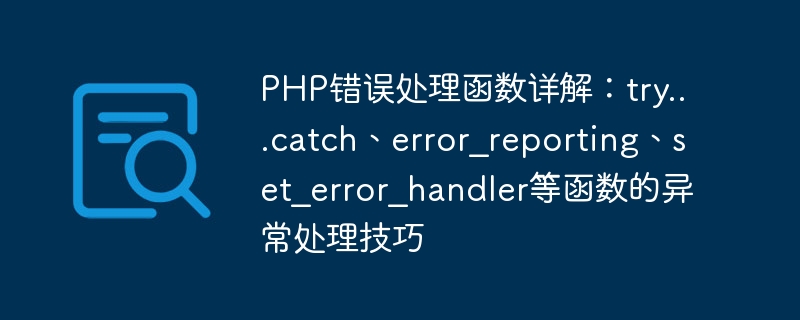

Detailed explanation of PHP error handling functions: Exception handling skills for try...catch, error_reporting, set_error_handler and other functions, specific code examples are needed
When we are developing PHP applications When programming, you often encounter various errors and exceptions. In order to ensure the stability and reliability of the application, we need to use appropriate error handling techniques to catch and handle these errors and exceptions. PHP provides multiple error handling functions, including try...catch, error_reporting, set_error_handler, etc.
1. Try...catch exception handling
The try...catch statement is a method of handling exceptions. Using the try...catch statement, we can place code that may throw exceptions in a try block and use the catch block to catch and handle these exceptions.
The following is a simple example that demonstrates how to use try...catch to handle exceptions:
try { // 可能抛出异常的代码 throw new Exception("这是一个异常"); } catch (Exception $e) { // 捕获异常并处理 echo "捕获到异常:" . $e->getMessage(); }
In the above example, we use the throw statement to manually throw an exception, Then catch and handle the exception in the catch block. Note that in the catch block, we use $e->getMessage() to get the details of the exception.
2. Error_reportingError reporting
The error_reporting function is used to set the error reporting level of PHP. We can use this function to control which types of errors need to be reported and displayed.
The following is an example that demonstrates how to use the error_reporting function to set the error reporting level:
// 设置错误报告级别为E_ALL(报告所有类型的错误) error_reporting(E_ALL); // 禁用错误报告 error_reporting(0);
In the above example, we use the error_reporting function to set the error reporting level to E_ALL and 0 respectively (Disable error reporting). When set to E_ALL, all types of errors are reported; when set to 0, no errors are reported.
3. Set_error_handler custom error handling function
The set_error_handler function allows us to define a custom error handling function to capture and handle errors during PHP runtime.
The following is an example that demonstrates how to use the set_error_handler function to define a custom error handling function:
// 自定义错误处理函数 function myErrorHandler($errno, $errstr, $errfile, $errline) { echo "错误代码:{$errno}
"; echo "错误消息:{$errstr}
"; echo "错误所在文件:{$errfile}
"; echo "错误所在行数:{$errline}
"; } // 将自定义错误处理函数注册为错误处理器 set_error_handler("myErrorHandler"); // 触发一个错误 echo $undefined_variable;
In the above example, we first define a custom error handling function" myErrorHandler" and then use the set_error_handler function to register it as an error handler. When an undefined variable error occurs, the custom error handling function will be called and the error details will be output.
Through the above example, we can see that custom error handling functions can be used to capture and handle errors during PHP runtime, so that we can better debug and maintain our applications.
To sum up, this article introduces in detail several commonly used error handling functions in PHP, including try...catch, error_reporting and set_error_handler, etc. By using these functions properly, we can better capture and handle errors and exceptions in PHP applications, thereby improving the stability and reliability of the application.
(Note: The code examples in this article are for reference only. Please modify and adapt according to specific needs for actual use.)
The above is the detailed content of Detailed explanation of PHP error handling functions: exception handling skills for try...catch, error_reporting, set_error_handler and other functions. For more information, please follow other related articles on the PHP Chinese website!




